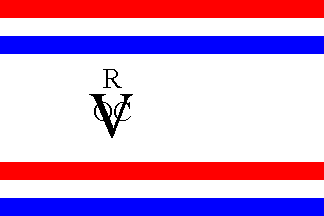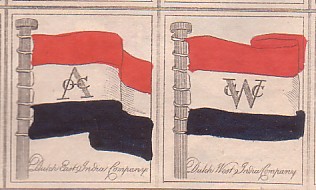Note: If an image ever fails to appear - refresh your page, it really is there
Flags of the United Dutch East Indies Company
The "Vereenigde Oostindische Compagnie (V.O.C. - United East India Company) existed between 1602-1798. It's ships were active in the East Indies (Asia) and later in the West Indies (the New World). Their house flag was the Dutch Tricolor with the Company emblem placed on the white stripe. The upper stripe of the flag of the V.O.C. was at first orange, but changed to red just as the top stripe on the Dutch national flag did between 1630 and 1660.
|
|
|
United East India Company
(original orange-ish colored stripe) |
|
United East India Company
(later red-ish colored stripe) |
The Flags of the Six Chambers
The Vereenigde Oostindische Compagnie was called "united" because it was actually six local companies, each based in a different Dutch city. They were Amsterdam, Delft, Enkhuizen, Hoorn, Middelburg, and Rotterdam. Each city had a flag of their own, thus lending to the confusion today.
|
|
|
Vereenigde Oostindische Compagnie, Amsterdam
|
|
Vereenigde Oostindische Compagnie, Delft
|
|
|
|
Vereenigde Oostindische Compagnie, Enkhuizen
|
|
Vereenigde Oostindische Compagnie, Hoorn
|
|
|
|
Vereenigde Oostindische Compagnie, Middelburg
|
|
Vereenigde Oostindische Compagnie, Rotterdam
|
 Vereenigde Oostindische Compagnie Vereenigde Oostindische Compagnie
Rotterdam AdministratorThe Flags of the V.O.C. Military
The Vereenigde Oostindische Compagnie also organized military units to protect their interest. These military units also carried regimental colors with the company emblem. They were normally all white with the V.O.C. emblem in the center. Some units, such as the Swiss mercenary regiment de Meuron added regimental honors and mottos on their flags. The Regiment de Meuron, for example, had "Terra et Mare" and "Fidelitas et Honor," inscribed across the top and bottom edges of the flag.
|
|
|
The Colonel's Colors |
|
Regiment de Meuron Colors |
Popular Myths and Fantasy Flags
The A.O.C. Fantasy Flag
Beginning in the early 19th Century reports of a different version of the Vereenigde Oostindische Compagnie flag were reported with a reversed V.O.C. emblem (possibly caused by careless hoistings of the V.O.C. flag upside down), as shown in such publications as the 1813 publication of "Principal Flags of All Nations in the World."

Drawing from 1813 publication
(Note: Right flag is for the Dutch "West" India Company)
Some modern variants of this flag with the reversed "V" claim the "A.O.C." stands for "Algemeene Oostindische Compagnie," or "General East India Company." Others claim the "A" stands for the City of "Amsterdam," but in reality, city initials never replaced the "V." These versions of the flag all stem from the original mistake, and it has been perpetuated ever since. The widespread acceptance of this flag gives us a classic example of a suppositious flag; an error repeated so often it becomes accepted as fact.
|
|
|
The suppositious A.O.C. Flag |
|
The "Cape Chamber" Flag |
The Cape Chamber Fantasy Flag
Another fantasy flag is the Vereenigde Oostindische Compagnie Cape Chamber flag with the "C" above the monogram. The only flags which bore an initial over the monogram, were those of the Chambers of the company, just the six of them. In their cases too, it was not on the "national" pattern flag, but on flags of their livery colors. The Cape was never a Chamber. It was under the management of the Middelburg Chamber. So, if any flag other than the V.O.C. flag were flown, it would have been that of Middelburg.
Interestedly enough, there was still such a dated replica flag hung in the Constantia Museum in 1997, and there was also an authentic Middelburg Chamber flag in the same museum, hanging directly opposite the "Cape Chamber" design. The "Cape Chamber" flag seems to have arisen from the custom of the V.O.C. in having its monogram with the initial of the local base or office marked on crockery and silverware used in that area. Hence, the appearance of such items with the "C" above the monogram, and even other initials for sub-divisions of the area. The same applied to their offices in Ceylon, and modern Indonesia. But they were only on tableware and, possibly, headed paper, but certainly never on flags.
In conclusion, it must be said, the Vereenigde Oostindische Compagnie was one of the most successful and ruthless of the Dutch maritime trading companies; but by the end of the 18th century it was struggling, and in 1798 it closed its doors permanently.
- My thanks to Michael Faul for his invaluable help on this page -
| Top of Page | Return to "The Dutch Explorers and Colonies" | Return to "Vexillological Essays and Chart Pages Menu" |
|